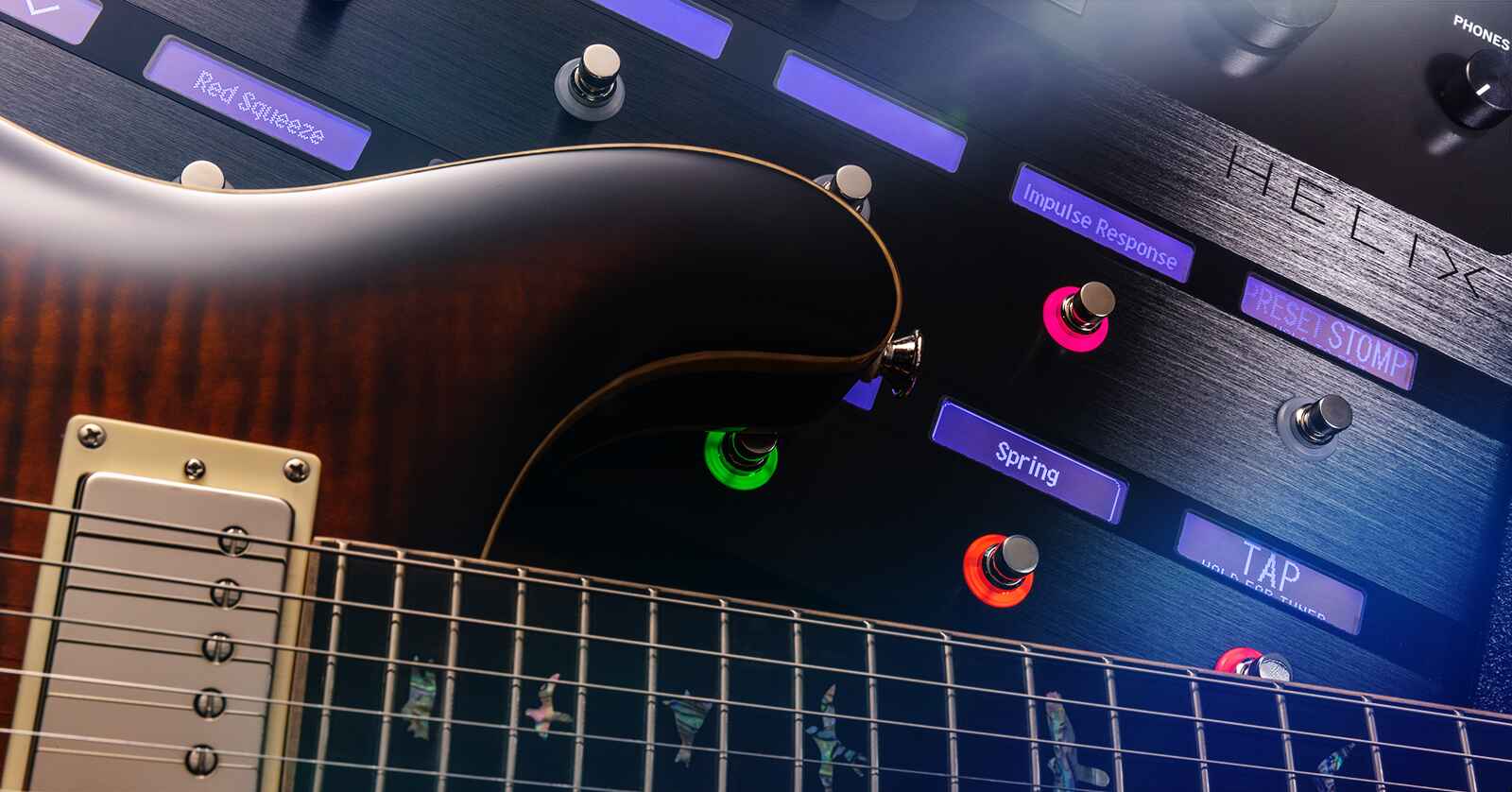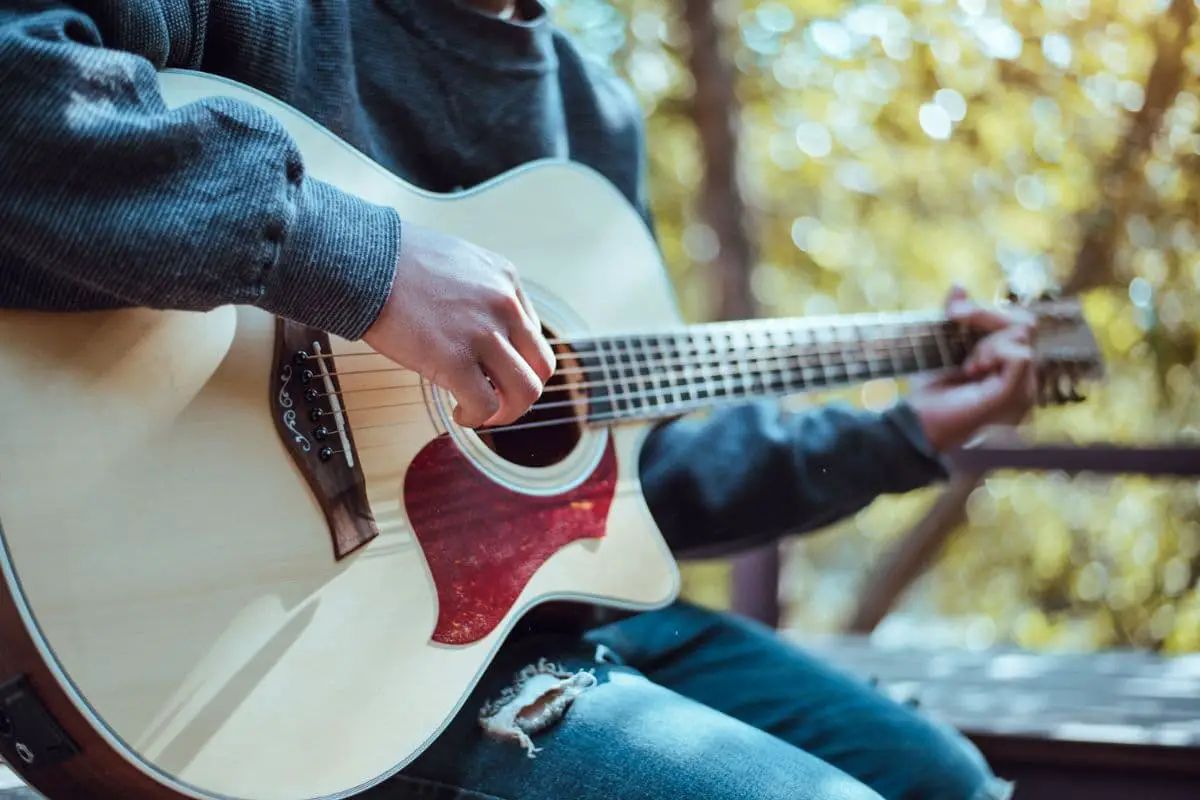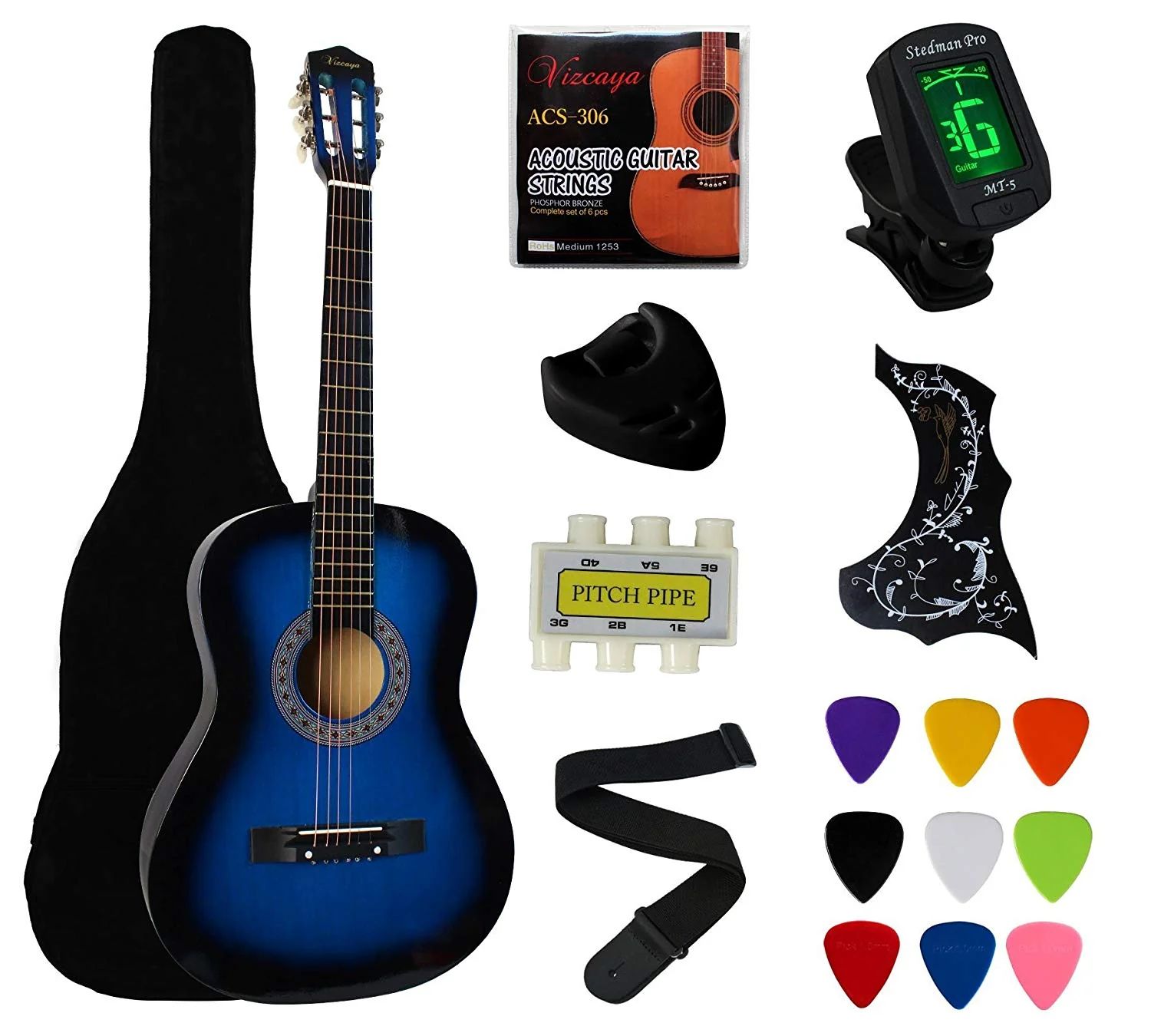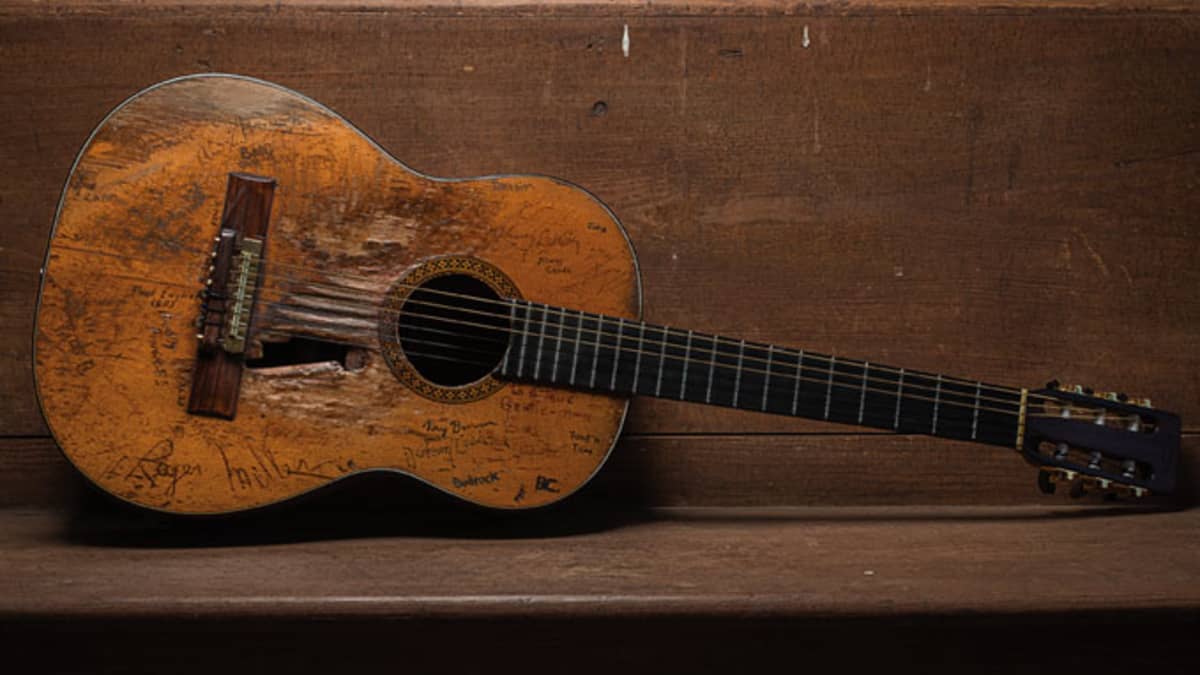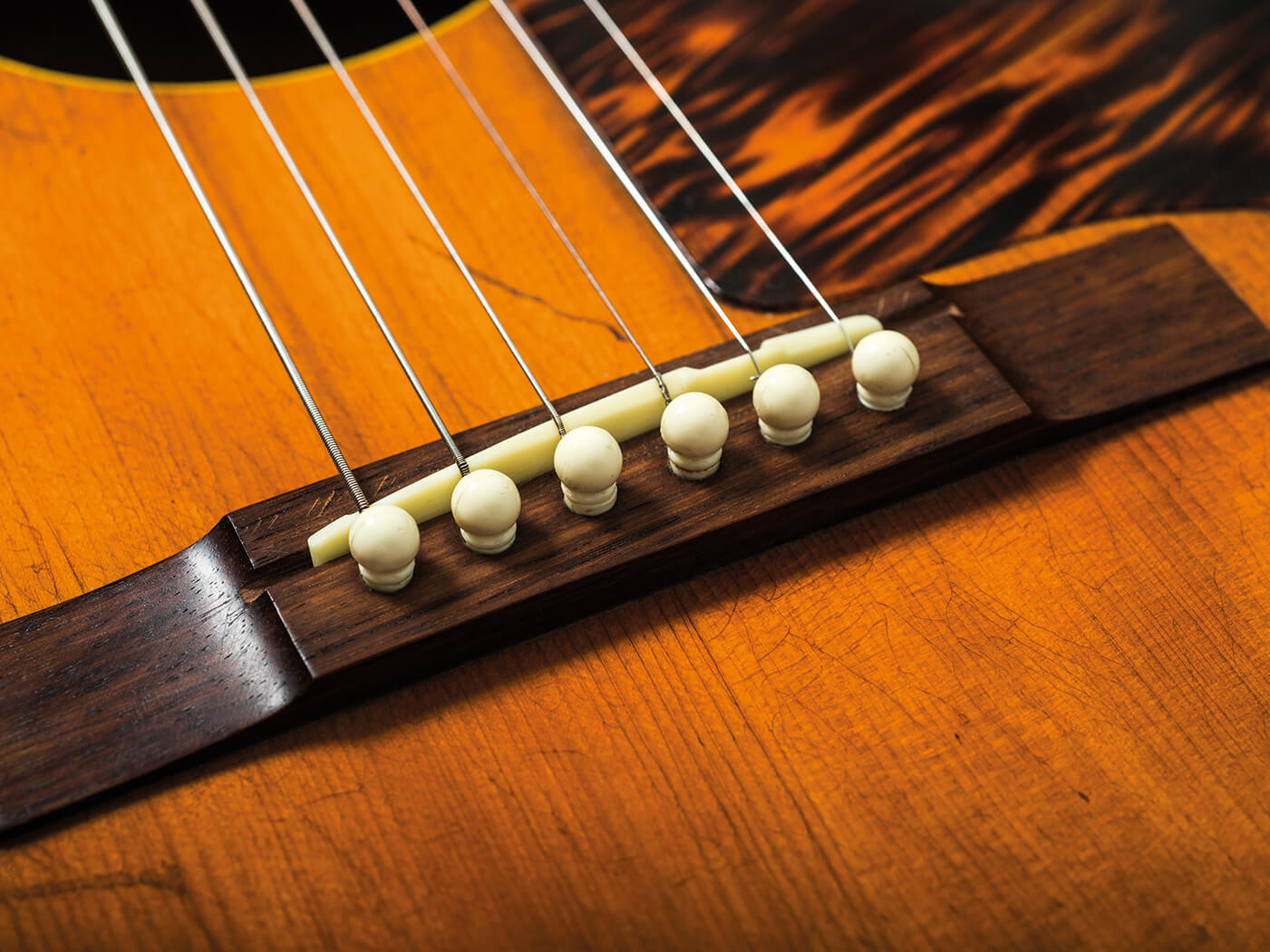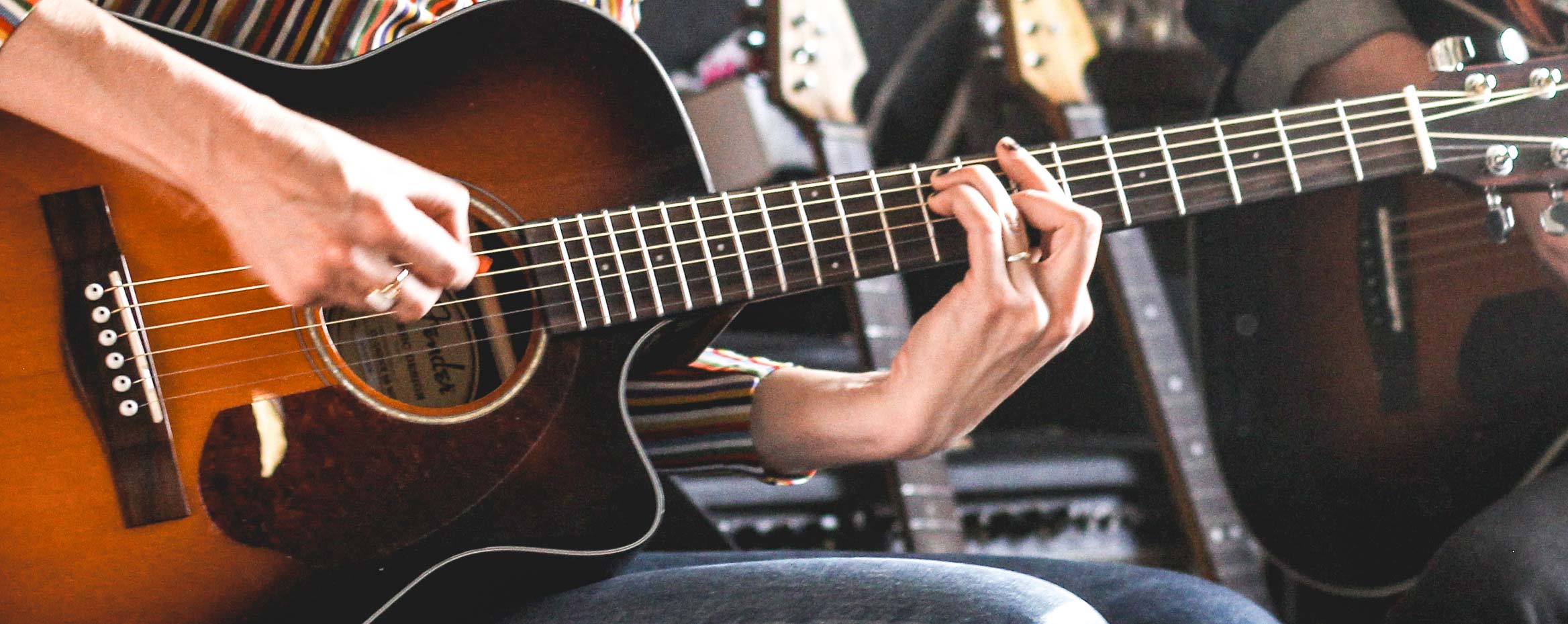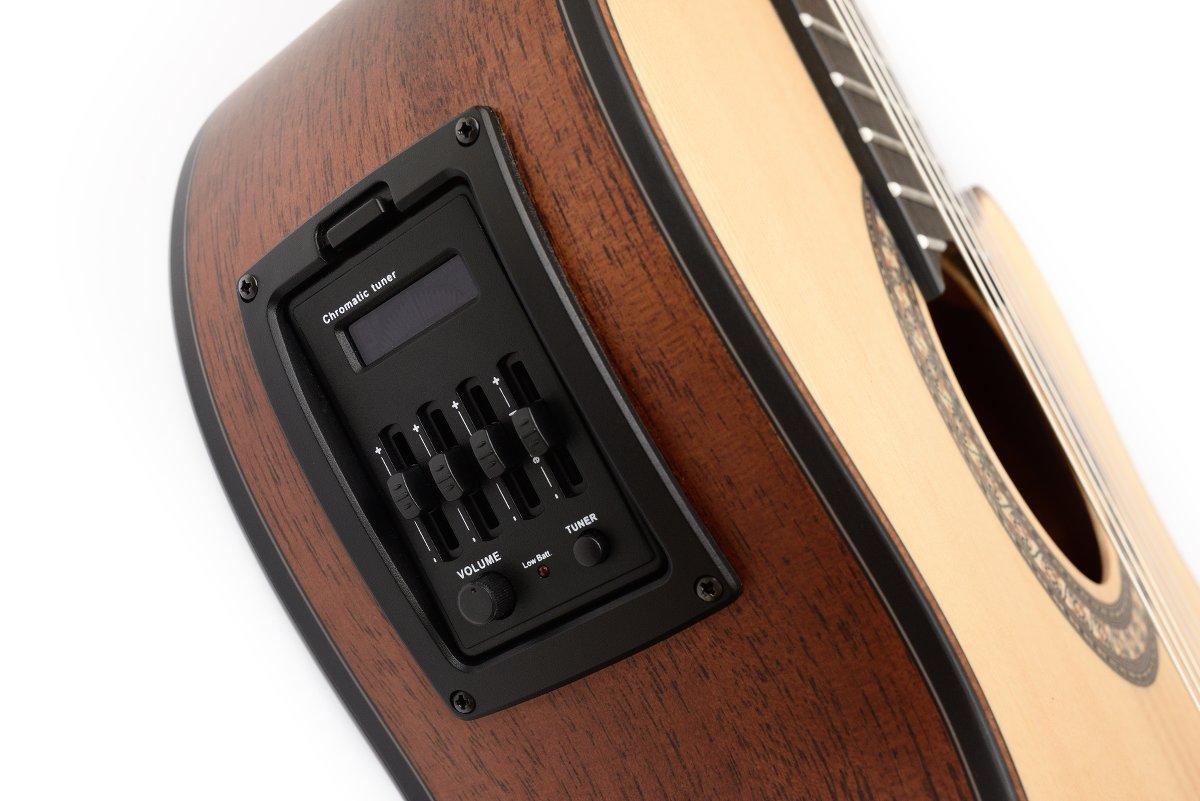Introduction
When it comes to playing the acoustic guitar, there are numerous techniques that add flavor and excitement to your playing. One such technique is tapping, which allows you to create intricate melodies and captivating rhythms using both hands on the fretboard. Tapping on the acoustic guitar may initially seem daunting, but with practice and determination, you can master this technique and take your playing to new heights.
Tapping on the acoustic guitar involves using your picking hand or fingers to strike the strings against the fretboard, producing distinct and vibrant notes. This technique has been popularized by legendary guitarists like Eddie Van Halen and Steve Vai, who have demonstrated its versatility through their unique and breathtaking performances.
Learning to tap on the acoustic guitar brings a plethora of benefits to your playing. It allows you to expand your musical vocabulary by creating complex melodies and harmonies that are difficult to achieve with conventional fretting techniques. Tapping also opens up a world of possibilities for soloing, enabling you to effortlessly play fast, melodic lines with precision and finesse.
If you’re eager to start tapping on the acoustic guitar but don’t know where to begin, this guide will take you step-by-step through the process. Whether you’re a beginner or an experienced guitarist, you’ll find valuable insights and techniques to improve your tapping skills and add a new dimension to your playing.
What is Tapping on Acoustic Guitar?
Tapping on the acoustic guitar is a technique that involves using your picking hand or fingers to tap on the fretboard, producing clear and distinct notes. Unlike traditional guitar playing where the fretting hand is primarily responsible for creating sound, tapping allows you to utilize both hands to produce complex melodies and rhythms.
During tapping, the picking hand acts as a hammer, quickly and firmly striking the strings against the fretboard. This creates a percussive effect, resulting in a unique and mesmerizing sound. Tapping can be performed on any part of the fretboard, allowing you to explore different tonal possibilities and unleash your creativity.
One of the defining features of tapping is the use of hammer-ons and pull-offs. This technique involves rapidly fretting a note with your fretting hand, then using your picking hand to forcefully tap on the string, causing it to sound. By lifting your tapping finger, you can seamlessly transition to different notes while maintaining a fluid and continuous sound.
Tapping on the acoustic guitar is often associated with fast, flashy solos, but it has a wide range of applications beyond soloing. It can be used to add embellishments and ornamentations to chords, create percussive rhythms, and even mimic other instruments such as drums or piano. The versatility of tapping allows you to express your musical ideas and experiment with different sounds and textures.
While tapping is commonly associated with electric guitar playing, it can also be effectively applied to acoustic guitar. Although the acoustic guitar may have a slightly different tone and dynamic response compared to its electric counterpart, tapping techniques can still be executed with proper technique and control.
In the following sections, we will explore the various tapping techniques, from basic to advanced, that you can incorporate in your acoustic guitar playing. By mastering these techniques and understanding the principles behind tapping, you will be able to create captivating and impressive sounds on your acoustic guitar.
Benefits of Tapping on Acoustic Guitar
Tapping on the acoustic guitar offers a multitude of benefits that can enhance your playing and expand your musical horizons. Whether you’re a beginner or an experienced guitarist, incorporating tapping into your acoustic guitar repertoire can take your playing to the next level. Here are some of the key benefits of tapping:
1. Enhanced Expressiveness
Tapping allows you to express yourself in ways that may be difficult to achieve with conventional guitar techniques. By utilizing both hands on the fretboard, you can create intricate melodies, dynamic chord progressions, and expressive solos. The percussive nature of tapping adds depth and emotion to your playing, enabling you to convey your musical ideas with precision and clarity.
2. Increased Speed and Agility
Tapping requires a certain level of dexterity and coordination between your picking and fretting hand. As you practice tapping techniques, you’ll gradually improve your speed and agility on the guitar. The ability to execute fast and precise tapping sequences will open up new possibilities for soloing and improvisation, allowing you to showcase your technical mastery and add flair to your playing.
3. Expanded Musical Vocabulary
Tapping introduces a whole new set of musical possibilities to your acoustic guitar playing. By combining tapping with other techniques such as hammer-ons, pull-offs, and slides, you can create complex and intricate musical phrases. This expands your musical vocabulary and allows you to explore different genres and styles of music with ease.
4. Improved Finger Strength and Control
Tapping requires a certain level of finger strength and control, particularly in your fretting hand. As you practice tapping techniques, you’ll strengthen your fingers and develop better control over the strings. This will not only benefit your tapping abilities but also enhance your overall guitar playing skills, making it easier to execute challenging chord shapes and complex fingerpicking patterns.
5. Creative Versatility
With tapping, you can experiment with a wide range of sounds and textures on your acoustic guitar. You can create harmonics, percussion-like rhythms, and melodic lines that push the boundaries of traditional guitar playing. Tapping allows you to think outside the box and explore unconventional approaches to music, giving you the freedom to express your creativity and unique musical vision.
By incorporating tapping into your acoustic guitar playing, you’ll not only enhance your technical skills but also unleash your creativity and musicality. The benefits of tapping are wide-ranging, and with practice and dedication, you’ll be able to achieve impressive and captivating performances on your acoustic guitar.
Getting Started with Tapping on Acoustic Guitar
If you’re new to tapping on the acoustic guitar, it’s essential to start with the basics and build a strong foundation. By following these steps, you’ll be on your way to mastering the art of tapping:
1. Familiarize Yourself with the Fretboard
Before diving into tapping, it’s crucial to have a good understanding of the fretboard. Familiarize yourself with the notes, scales, and chord positions. This knowledge will provide you with a solid framework to work with and enable you to navigate the fretboard effectively while tapping.
2. Practice Proper Hand Positioning
When tapping on the acoustic guitar, the hand positioning is crucial. Place your fretting hand on the neck of the guitar, ensuring that your thumb rests comfortably on the back of the neck for support. Your picking hand should be positioned above the fretboard, ready to execute the tapping motion. Find a hand position that feels natural and allows for efficient movement.
3. Start with Basic Tapping Exercises
Begin by practicing basic tapping exercises to develop your coordination and precision. Start by tapping on a single string, using your picking hand to strike the fretboard firmly and cleanly. Focus on producing clear and distinct notes. Gradually increase the tempo and experiment with different finger combinations to expand your range.
4. Incorporate Hammer-ons and Pull-offs
As you become comfortable with basic tapping exercises, incorporate hammer-ons and pull-offs into your playing. Experiment with different finger combinations and practice transitioning between notes smoothly. These techniques will add depth and fluidity to your tapping phrases and allow for seamless transitions between notes.
5. Gradually Increase Complexity
Once you have attained proficiency in the basic tapping techniques, gradually increase the complexity of your tapping exercises. Explore different patterns, arpeggios, and scales, incorporating tapping into your solos and improvisations. Challenge yourself to incorporate both hands on the fretboard simultaneously to achieve more intricate and engaging musical phrases.
6. Record and Evaluate Your Progress
Recording your tapping practice sessions can be invaluable for assessing your progress. Listen back to your recordings, paying attention to your timing, clarity, and overall technique. This will help you identify areas for improvement and allow you to refine your skills over time.
Remember, mastery of tapping on the acoustic guitar takes time and dedication. Be patient with yourself and embrace the learning process. With consistent practice and a growth mindset, you’ll steadily improve your tapping abilities and unlock an exciting world of musical possibilities on your acoustic guitar.
Basic Tapping Techniques
Mastering the basic tapping techniques is essential for building a strong foundation in your acoustic guitar playing. These techniques will provide you with the tools to create melodic lines, add embellishments to chords, and explore new musical possibilities. Here are some of the fundamental tapping techniques to get you started:
1. Single-Note Tapping
Single-note tapping involves tapping on one string with your picking hand while using your fretting hand to hold down a note on a different string. To execute this technique, place your picking hand above the desired fret on the target string and use your picking finger or thumb to tap down firmly, producing a clear and distinct note. The note fretted by your fretting hand should be held down throughout the duration of the tapping motion.
2. Hammer-ons and Pull-offs
Hammer-ons and pull-offs are fundamental techniques used in tapping. A hammer-on is when you tap a note with your picking hand and then, without plucking the string again, fret a higher note with your fretting hand. This creates a seamless transition between notes. A pull-off is the reverse motion, where you tap a note with your picking hand and then pull-off to a lower fretted note using your fretting hand. Practice hammer-ons and pull-offs in combination with tapping to create fluid and expressive melodies.
3. Tapping Arpeggios
Arpeggios are an excellent way to incorporate tapping into your acoustic guitar playing. Start by learning basic arpeggio shapes, such as major and minor triads or seventh chords. Use your picking hand to tap the notes of the arpeggios on the higher strings while your fretting hand holds down the lower string notes. This technique allows you to create rich and harmonically interesting sounds.
4. Tapping with Both Hands
Once you have mastered single-note tapping, you can start exploring more advanced techniques that involve using both hands to tap on the fretboard simultaneously. This technique adds complexity and depth to your playing. Experiment with tapping on different strings with both hands to create complex rhythms, harmonies, and melodic patterns.
5. Tapping Combinations
As you become more comfortable with the basic tapping techniques, try combining them to create more intricate and interesting musical phrases. Mix single-note tapping with hammer-ons and pull-offs, incorporate arpeggios, and experiment with different finger combinations. This will allow you to develop your own unique tapping style and explore a wide range of musical ideas.
Remember, practice and repetition are key to mastering these basic tapping techniques. Start slowly and gradually increase your speed and complexity over time. Take the time to develop accuracy, clarity, and control in your tapping motions. With regular practice and a willingness to explore, you’ll soon find yourself effortlessly incorporating these techniques into your acoustic guitar playing.
Intermediate Tapping Techniques
Once you have grasped the basic tapping techniques, it’s time to expand your repertoire with intermediate tapping techniques. These techniques will take your acoustic guitar playing to the next level, allowing you to create more intricate and dynamic musical phrases. Here are some intermediate tapping techniques to explore:
1. Two-Handed Tapping
Two-handed tapping is a technique where you use both hands to tap on the fretboard simultaneously. This technique creates a unique and complex sound as you can play multiple notes or harmonies simultaneously. Experiment with different finger combinations and patterns to create melodic, chordal, or percussive textures. You can tap with both hands on separate strings or explore tapping on the same string to produce harmonies and intervals.
2. Tapping Slides
Tapping slides involve tapping a note and then sliding your tapping finger up or down the fretboard to reach higher or lower notes. This technique adds a smooth and fluid quality to your tapping phrases. Practice sliding between different notes and experiment with different intervals and directions to create expressive and dynamic passages.
3. Tapped Harmonics
Tapping harmonics is a technique that allows you to create shimmering and ethereal sounds. Instead of tapping on a fretted note, lightly tap directly above the fretwire to produce harmonics. Experiment with different places along the string and different finger placements to discover harmonics with different pitches. Tapped harmonics can add a beautiful and haunting quality to your acoustic guitar playing.
4. Double-Handed Tapping Trills
A trill is a rapid alternation between two notes. With double-handed tapping trills, you combine tapping with hammer-ons and pull-offs to create rapid and fluid trills. Start by tapping a note and then alternate between fretting a higher note and releasing the tapped note. This technique adds speed, agility, and excitement to your playing, allowing you to create impressive musical passages.
5. Tapping Chord Voicings
Tapping can also be applied to chord playing. Experiment with tapping different chord voicings and shapes using both hands on the fretboard. By combining tapping with strumming or picking, you can create rich and harmonically interesting chord progressions. This technique opens up a world of possibilities for chordal exploration and allows you to create unique and captivating accompaniment patterns.
As with any new technique, take the time to practice and slowly incorporate these intermediate tapping techniques into your acoustic guitar playing. Start at a comfortable pace and gradually increase the speed and complexity. Explore different musical genres and styles to find the best contexts in which to apply these techniques. Remember, the goal is to add depth, expression, and excitement to your playing through the mastery of intermediate tapping techniques.
Advanced Tapping Techniques
For those looking to push the boundaries of their acoustic guitar playing, advanced tapping techniques offer a world of exploration and creativity. These techniques require a higher level of skill, precision, and coordination, but the rewards are well worth the effort. Here are some advanced tapping techniques to challenge and inspire you:
1. Tapping Arpeggio Sweeps
Tapping arpeggio sweeps combine two advanced techniques: sweeping and tapping. Start by holding down a chord shape with your fretting hand and use your picking hand to tap the individual notes of the arpeggio. As you tap each note, pull-off to the next lower note with your fretting hand, creating a sweeping motion. This technique allows for seamless and fluid arpeggio movements and adds a dazzling display of speed and precision to your playing.
2. Tapping with Two Fingers
While most tapping techniques utilize a single finger from the picking hand, advanced tapping involves using two fingers simultaneously. This allows for greater speed and complexity. Experiment with tapping combinations using your index and middle finger, or any other combination that feels comfortable for you. This technique opens up a wider range of possibilities for creating intricate melodic patterns and harmonies.
3. Harmonic Tapping
Harmonic tapping involves tapping directly on the frets to produce harmonics, creating a unique and celestial quality to your playing. Experiment with tapping at different points on the frets to create different harmonic intervals. Combine harmonic tapping with other techniques, such as slides or trills, to create captivating and otherworldly sounds.
4. Tapping Patterns and Sequences
Moving beyond individual notes, advanced tapping techniques often incorporate complex patterns and sequences. This involves tapping a series of notes in a specific sequence or rhythm. Practice different tapping patterns, such as ascending or descending patterns, repeating sequences, or syncopated rhythms. This technique adds depth and complexity to your solos or improvisations.
5. Tapping with Hybrid Picking
Hybrid picking combines tapping with traditional picking techniques. Use your picking hand to pluck some strings while tapping notes on other strings simultaneously. This technique allows for intricate melodies and harmonies to be played simultaneously, creating a layered and rich sound. Experiment with different picking and tapping combinations to find the most intuitive and comfortable approach for your playing style.
Advanced tapping techniques require consistent practice and dedication to develop the required speed, coordination, and precision. Start by mastering the foundational tapping techniques before progressing to these more advanced techniques. Break down the techniques into smaller parts and practice them slowly, gradually increasing the tempo. As you become more comfortable, experiment with incorporating these advanced techniques into your own compositions or improvisations, allowing your creativity to soar and your guitar playing to reach new heights.
Tips for Improving Your Tapping Skills
Improving your tapping skills on the acoustic guitar requires practice, patience, and a focused approach. Here are some tips to help you enhance your tapping abilities and take your acoustic guitar playing to the next level:
1. Start Slow and Gradually Increase Speed
Tapping can be a complex technique, so it’s important to start slowly and focus on accuracy and clarity. Begin by practicing at a comfortable tempo and gradually increase the speed as you build confidence and control. This gradual progression will ensure that you develop proper technique and avoid sacrificing accuracy for speed.
2. Isolate and Practice Problematic Sections
If you encounter specific sections or techniques that you find challenging, isolate those parts and practice them separately. Break them down into smaller segments and repeat them until you feel comfortable. Then gradually reintegrate them into the larger context of the piece or exercise you’re working on. This targeted approach helps overcome technical hurdles and allows for more efficient progress.
3. Utilize Metronome and Backing Tracks
Practicing with a metronome is essential for developing precise timing and rhythm. Set the metronome to a comfortable tempo and play along, gradually increasing the speed over time. Additionally, playing with backing tracks or jamming with other musicians can help improve your sense of groove and enhance your overall musicality.
4. Focus on Accuracy and Clean Articulation
Paying attention to accuracy and clean articulation is crucial when tapping on the acoustic guitar. Ensure that each tapped note is clear and distinct, with no unwanted string noises or buzzing. Practice lifting your fingers off the strings efficiently to prevent any unintentional dampening or muting of the sound. A clean and precise technique will make your tapping phrases sound polished and professional.
5. Experiment with Different Finger Combinations
Explore different finger combinations while tapping to discover the ones that feel most comfortable and effective for you. Some guitarists prefer using their index finger, while others find success with their middle or ring finger. Experiment with different combinations, such as tapping with two fingers simultaneously or incorporating your thumb. Find what works best for your playing style and musical goals.
6. Study and Learn from Experienced Guitarists
Study the techniques and styles of experienced guitarists known for their tapping skills. Watch live performances and instructional videos to observe their hand positions, fingering techniques, and overall approach to tapping. Take inspiration from their playing and try to incorporate their ideas into your own practice routine.
7. Record and Analyze Your Practice Sessions
Recording your tapping practice sessions allows you to listen back and analyze your playing objectively. Pay attention to areas that need improvement and identify any technical or timing issues. Take note of your progress over time and celebrate the small victories along the way. This self-assessment will guide your practice and help you target areas for growth.
Remember, developing your tapping skills on the acoustic guitar takes time and dedication. Consistent and focused practice, along with a willingness to challenge yourself, will yield noticeable improvements. Enjoy the journey and embrace the process of mastering this exciting technique, and soon you will be creating captivating and impressive performances on your acoustic guitar.
Popular Songs with Tapping on Acoustic Guitar
While tapping is often associated with electric guitar playing, there are several popular songs where acoustic guitarists have showcased their tapping skills. These songs demonstrate the versatility of tapping and how it can be effectively incorporated into acoustic guitar music. Here are a few examples of popular songs that feature tapping on the acoustic guitar:
1. “Dee” by Randy Rhoads
Randy Rhoads, known for his incredible guitar skills, showcased tapping in his instrumental piece “Dee.” This song features a beautiful and melodic tapping passage that demonstrates the expressive qualities of tapping on the acoustic guitar. Learning this piece will not only develop your tapping technique but also enhance your overall fingerstyle playing.
2. “Ebon Coast” by Andy McKee
Andy McKee is renowned for his percussive and innovative acoustic guitar playing. In his composition “Ebon Coast,” he incorporates tapping extensively to create a mesmerizing array of melodies and textures. The song combines intricate fingerstyle patterns with tapping techniques, providing a challenging yet rewarding experience for acoustic guitarists looking to improve their tapping skills.
3. “Drifting” by Andy McKee
In another popular song by Andy McKee, “Drifting,” he incorporates tapping to create a captivating and rhythmic acoustic guitar piece. The song showcases his ability to weave intricate tapping patterns into a beautiful composition that pushes the boundaries of what is possible on the acoustic guitar. Learning this song will help you develop precision, control, and creativity with your tapping technique.
4. “Sevillana” by Estas Tonne
Estas Tonne, known for his unique guitar style, incorporates tapping techniques in his composition “Sevillana.” This piece features explosive rhythms and intricate tapping passages, combining elements of flamenco and modern acoustic guitar. Learning and playing this song will enhance your rhythmic abilities and allow you to delve into the world of percussive and expressive acoustic guitar playing.
5. “Dust in the Wind” by Kansas (Acoustic Version)
“Dust in the Wind” is a classic acoustic song by Kansas, and while the original version does not include tapping, the acoustic renditions often incorporate tapping techniques to add embellishments and variations. Tapping can be employed to create melodic fills and improvisations during the various instrumental sections of the song, adding a fresh twist to this timeless acoustic piece.
These songs represent just a sample of the numerous possibilities for incorporating tapping into acoustic guitar playing. As you explore and learn these songs, you’ll not only improve your tapping skills but also gain a deeper understanding of how tapping can enhance your overall musicality on the acoustic guitar.
Common Mistakes to Avoid while Tapping on Acoustic Guitar
Tapping on the acoustic guitar can be challenging, especially when you’re just starting to learn the technique. To ensure that you make progress and maintain good technique, it’s important to be aware of common mistakes to avoid. By avoiding these pitfalls, you’ll develop clean and precise tapping skills on the acoustic guitar. Here are some common mistakes to watch out for:
1. Insufficient Finger Strength
A common mistake is not developing enough finger strength to execute tapping accurately. Tapping requires a firm and controlled touch, so it’s crucial to strengthen your fingers through regular practice. Incorporate finger exercises and hand-strengthening techniques into your routine to build the necessary finger strength for clean tapping.
2. Neglecting Hand Positioning
Hand positioning plays a crucial role in tapping. It’s important to position your hands correctly to ensure efficient movement and optimal control. Make sure your picking hand is positioned above the fretboard, ready to tap, while your fretting hand is positioned comfortably on the neck. Avoid excessive tension or awkward angles that can hinder your tapping accuracy and speed.
3. Over-reliance on Force
One common mistake is using excessive force when tapping on the fretboard. Tapping should be executed with controlled and precise movements, rather than relying solely on brute strength. Focus on using just enough force to produce clear and distinct notes without causing unnecessary strain on your fingers or the guitar strings.
4. Inaccurate String Muting
Tapping involves multiple strings, so it’s important to pay attention to string muting to avoid unwanted noise. Make sure to mute the unused strings with your fretting hand to prevent unintentional string vibrations and ensure a clean sound. This will help you maintain clarity and avoid unintended notes ringing out, especially when tapping on adjacent strings.
5. Lack of Timing and Rhythm
Tapping requires good timing and rhythm to create cohesive musical phrases. A common mistake is neglecting the importance of timing while focusing solely on executing the tapping technique. Practice with a metronome to develop a sense of timing, and pay attention to the rhythmic relationship between tapping and other playing elements such as strumming or picking.
6. Not Paying Attention to Note Articulation
Each tapped note should be articulate and clear. A mistake to avoid is not paying attention to the duration and dynamics of each note. Practice tapping with consistent pressure and accuracy, and ensure that each note is audible and well-articulated. This will add expressiveness and musicality to your tapping phrases.
7. Lack of Variation and Musicality
Tapping should not be limited to repetitive patterns or monotonous sequences. A mistake to avoid is not exploring different rhythms, intervals, and musical ideas in your tapping. Experiment with different tapping techniques, dynamics, and phrasing to develop your own unique style and add musicality to your playing.
By being aware of these common mistakes and actively working to avoid them, you’ll improve your tapping technique and develop a clean and precise playing style on the acoustic guitar. Embrace a mindset of continuous improvement, and regularly assess your technique to ensure that you’re progressing towards flawless tapping skills.
Conclusion
Tapping on the acoustic guitar is an exciting and versatile technique that allows you to unlock new possibilities in your playing. By incorporating tapping, you can create intricate melodies, add embellishments to chords, and explore a range of musical styles and genres. As you embark on your tapping journey, remember to start with the basics, develop a strong foundation, and gradually progress to more advanced techniques.
Practice is key when it comes to improving your tapping skills. Start slowly and focus on accuracy and clarity, gradually increasing speed and complexity over time. Avoid common mistakes such as insufficient finger strength or neglecting hand positioning. Instead, prioritize proper technique and develop your finger dexterity through regular practice and targeted exercises.
Explore different finger combinations and experiment with various patterns and rhythms to add depth and diversity to your tapping phrases. Practice with a metronome, record your progress, and analyze your playing to identify areas for improvement. Learning and studying songs that incorporate tapping will also expand your repertoire and inspire new ideas for your own playing.
Remember, the journey of mastering tapping on the acoustic guitar is a personal one. Embrace the process, stay patient, and celebrate even the smallest victories along the way. Enjoy the creativity and expressiveness that tapping brings to your playing, and use it as a tool to develop your own unique musical voice.
With dedication, practice, and an open mind, you’ll continue to grow as a guitarist and tap into the vast potential of the acoustic guitar. So, grab your guitar, start tapping, and embark on an exciting musical adventure that will elevate your playing to new heights.







